Wreck ‘Em Up
Ken Neill, III
published in The Fisherman
Fall is a time of transition. You may be reaching for a coat in October or you might be out there throwing the football around, wearing short sleeves, after finishing your Thanksgiving dinner. It is a time of transition in the water also. Our summer visitors from the south school up in preparation for their trip back to their wintering grounds. The fish that spent their summer months up off of New England come back to spend the cooler weather months with us. Fall is the time that you can catch them all. It is the best time of the year to fish the inshore waters of Virginia and the many wrecks and artificial reefs are the place to be. These structures are the hotels for these traveling fish.
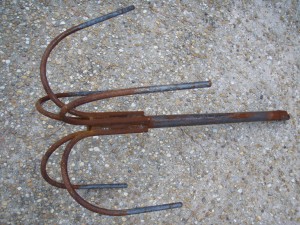 The only special equipment that you need to fish these fish magnets is a wreck anchor. It is a grappling type anchor which will let you position your boat directly over the structure. The tines are designed to straighten when you are ready to leave. Get one with tines thick enough to hold the weight of your boat but not so stiff that you will have a hard time straightening them out when you power away from the wreck.
The only special equipment that you need to fish these fish magnets is a wreck anchor. It is a grappling type anchor which will let you position your boat directly over the structure. The tines are designed to straighten when you are ready to leave. Get one with tines thick enough to hold the weight of your boat but not so stiff that you will have a hard time straightening them out when you power away from the wreck.
Early Fall
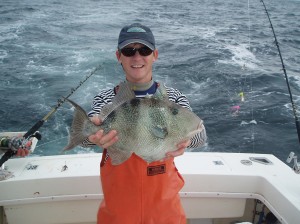 You can divide this fall bonanza into early and late seasons. The early part is a continuation of our summer fishery, only better. The fish that have been scattered all over the place concentrate on the inshore wrecks and feed heavily. This a wonderful mixed-bag fishery. You just never know what you are going to catch. Anchor up and fish down in the structure and you are liable to bring up anything. Sea bass, tautog, sheepshead, triggerfish, red drum, black drum and porgy are common catches and even something like a tripletail, grouper or snapper may show up. A variety of shark species will be found around the structure to add to the excitement.
You can divide this fall bonanza into early and late seasons. The early part is a continuation of our summer fishery, only better. The fish that have been scattered all over the place concentrate on the inshore wrecks and feed heavily. This a wonderful mixed-bag fishery. You just never know what you are going to catch. Anchor up and fish down in the structure and you are liable to bring up anything. Sea bass, tautog, sheepshead, triggerfish, red drum, black drum and porgy are common catches and even something like a tripletail, grouper or snapper may show up. A variety of shark species will be found around the structure to add to the excitement.
You can pull the anchor and work the edges of the structure for some of the best flounder fishing of the year. You will find big flatfish around all of the inshore wrecks but some of the best locations for fall flounder fishing are the Tower Reef, the Triangle Wrecks, and the Brass Spike. Big strip baits and live fish in the 4-6 inch size will both produce doormat-sized flounder.
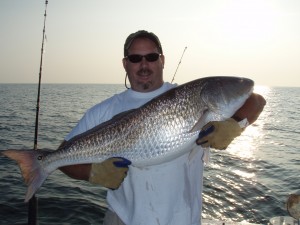 Higher up in the water column, you will also find plenty of fish. A simple way to fish this area is to break out your trolling spoons. Troll a combination of spoons like the 3 ½ Drone and the No. 1 Clark and expect to battle king mackerel, Spanish mackerel, and false albacore. You can get a surprise doing this also. One October, we were catching king mackerel and false albacore while trolling around the Santore when one of our spoons was eaten by a 25-pound dolphin. When trolling these spoons, use a leader about 25 feet long. Tie your leader directly to the spoon. Do not use a snap. Halfway up your leader, place a swivel to help prevent line twist. The other end of your leader material is attached to a planer or an in-line sinker with a snap swivel.
Higher up in the water column, you will also find plenty of fish. A simple way to fish this area is to break out your trolling spoons. Troll a combination of spoons like the 3 ½ Drone and the No. 1 Clark and expect to battle king mackerel, Spanish mackerel, and false albacore. You can get a surprise doing this also. One October, we were catching king mackerel and false albacore while trolling around the Santore when one of our spoons was eaten by a 25-pound dolphin. When trolling these spoons, use a leader about 25 feet long. Tie your leader directly to the spoon. Do not use a snap. Halfway up your leader, place a swivel to help prevent line twist. The other end of your leader material is attached to a planer or an in-line sinker with a snap swivel.
If you have a strong back, drop a live croaker down and drift it over the top of the structure and hang on. You will 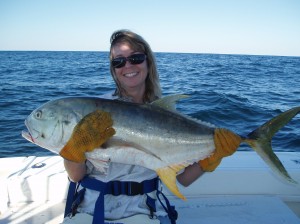 find that the amberjack and jack crevalle are big, mean, and hungry. The largest jacks of the year will be caught during this time of the year. Use tackle with some backbone. A leader of 80-100 lb test is attached to your main line with swivel. Above the swivel, place a sinker slide so you can attach a weight to encourage your bait to get down there to where jacks are waiting.
find that the amberjack and jack crevalle are big, mean, and hungry. The largest jacks of the year will be caught during this time of the year. Use tackle with some backbone. A leader of 80-100 lb test is attached to your main line with swivel. Above the swivel, place a sinker slide so you can attach a weight to encourage your bait to get down there to where jacks are waiting.
Late Fall
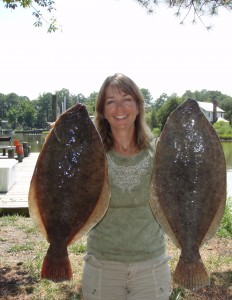 As the season progresses, the mackerel and false albacore will be replaced by bluefish. Following the bluefish will be bluefin tuna and big thresher sharks. Flounder will continue to be caught down on the bottom. Fish caught directly in the structure will become mostly sea bass and tautog though the trigger fish will hang around for awhile. The surprise catches will now be colder water fish like pollock and hake. A typical fishing trip this time of the year will be to anchor up on a wreck and start a chum slick. You drop down to the wreck and start catching sea bass and tautog until your sea bass and tautog start coming up missing their back halves. Then it is time to start catching chopper bluefish. Drift back chunks of cut bait or for more fun, break out the casting gear and start working top-water baits. Once you have caught some bluefish, you now have some bait for a thresher. While fishing, keep your eye out for tuna busting on the surface.
As the season progresses, the mackerel and false albacore will be replaced by bluefish. Following the bluefish will be bluefin tuna and big thresher sharks. Flounder will continue to be caught down on the bottom. Fish caught directly in the structure will become mostly sea bass and tautog though the trigger fish will hang around for awhile. The surprise catches will now be colder water fish like pollock and hake. A typical fishing trip this time of the year will be to anchor up on a wreck and start a chum slick. You drop down to the wreck and start catching sea bass and tautog until your sea bass and tautog start coming up missing their back halves. Then it is time to start catching chopper bluefish. Drift back chunks of cut bait or for more fun, break out the casting gear and start working top-water baits. Once you have caught some bluefish, you now have some bait for a thresher. While fishing, keep your eye out for tuna busting on the surface.
 During this late fall period, school bluefin tuna will invade our waters and can be found all the way into the beach. Every year, a few are caught by anglers fishing for rockfish in close to shore. To target these fish, spend your time around wrecks like the Hanks, Ricks, and the Triangle Wrecks. Most of these fish will be in the 50 to 125 pound class though there is the possibility of a larger fish taking your bait so be prepared. These fish can be very frustrating at times. It is not uncommon to see bluefin rolling all over the surface and to not be able to get them to bite. There are some tricks that can make them cooperate. You can try the normal bluefin techniques. Try chunking or trolling ballyhoo/Ilander combinations well behind the boat. Both will work and both will be ignored at times. You can put a bait down behind a planer. Pull a Stretch 30, sometimes they will bite this when they ignore the normal tuna baits. You can try skipping a spoon along the surface. Something that greatly increases your chances is to be trolling by first light. Often, you will get bites at the first hint of light and then have all of your baits ignored for the rest of the day.
During this late fall period, school bluefin tuna will invade our waters and can be found all the way into the beach. Every year, a few are caught by anglers fishing for rockfish in close to shore. To target these fish, spend your time around wrecks like the Hanks, Ricks, and the Triangle Wrecks. Most of these fish will be in the 50 to 125 pound class though there is the possibility of a larger fish taking your bait so be prepared. These fish can be very frustrating at times. It is not uncommon to see bluefin rolling all over the surface and to not be able to get them to bite. There are some tricks that can make them cooperate. You can try the normal bluefin techniques. Try chunking or trolling ballyhoo/Ilander combinations well behind the boat. Both will work and both will be ignored at times. You can put a bait down behind a planer. Pull a Stretch 30, sometimes they will bite this when they ignore the normal tuna baits. You can try skipping a spoon along the surface. Something that greatly increases your chances is to be trolling by first light. Often, you will get bites at the first hint of light and then have all of your baits ignored for the rest of the day.
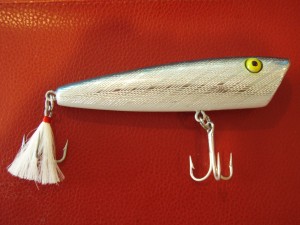 If you have bluefin tuna ignoring your chunks and trolled baits, you can get them to bite if you want to. Break out your spinning gear and cast a top-water popper into the rolling tuna and work it back to the boat very fast. They will hit this bait, often knocking it well out of the water and then hitting it again when it splashes back down. Once you hook-up, pass the rod to someone else. 50-pound fish are OK on this tackle. If you tie into a larger fish, expect a long fight. I once fought one of these fish for 6.5 hours before I was able to bring it to the gaff. That happened once, now I pass the rod to someone else who does not know better. Trade out the hooks and split rings that come with the lure for sturdier stuff. Here is a secret. These top-water baits usually come with hair on the trailing treble hook. This works great when you are casting to the bluefish in your chum slick. For some reason, tuna do not like this hair so trade out that hook for a plain one.
If you have bluefin tuna ignoring your chunks and trolled baits, you can get them to bite if you want to. Break out your spinning gear and cast a top-water popper into the rolling tuna and work it back to the boat very fast. They will hit this bait, often knocking it well out of the water and then hitting it again when it splashes back down. Once you hook-up, pass the rod to someone else. 50-pound fish are OK on this tackle. If you tie into a larger fish, expect a long fight. I once fought one of these fish for 6.5 hours before I was able to bring it to the gaff. That happened once, now I pass the rod to someone else who does not know better. Trade out the hooks and split rings that come with the lure for sturdier stuff. Here is a secret. These top-water baits usually come with hair on the trailing treble hook. This works great when you are casting to the bluefish in your chum slick. For some reason, tuna do not like this hair so trade out that hook for a plain one.
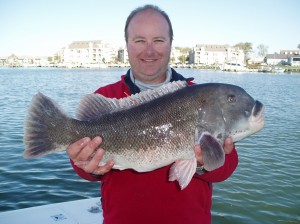 Load up your wreck anchor, some squid, some clams or crabs, maybe some live spot and croaker, spoons, top-water baits, maybe some chum and get on out there and wreck ‘em up!
Load up your wreck anchor, some squid, some clams or crabs, maybe some live spot and croaker, spoons, top-water baits, maybe some chum and get on out there and wreck ‘em up!
Detailed information about Virginia’s artificial reefs, including the Tower Reef and the Triangle Wrecks, can be found at:
www.mrc.virginia.gov/vsrfdf/reef.shtm
Some Inshore Wrecks:
Brass Spike: 36 55.818’N 075 33.910’W
Santore: 36 53..846’N 075 46.864’W
Powell: 36 49.060’N 075 23.822’W
4A Drydock: 36 35.918’N 075 41.871’W
Ricks: 36 47.883’N 075 29.518’W
Hanks: 36 43.710’N 075 34.153’W
Consols: 36 28.485’N 075 38.403’W
Luckenenbach 36 58.543’N 075 24.850’W
